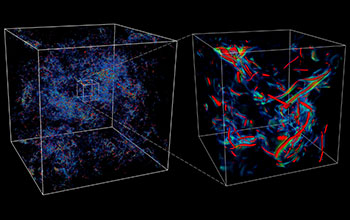Multimedia Gallery
Turbulence Research
Fluctuations of the energy dissipation rate and enstrophy represent, respectively, the intensity of local straining and rotation that are important for understanding the effects of turbulent fluid motions in problems such as combustion and pollution dispersion. This figure is a sample visualization, performed at the Texas Advanced Computing Center (TACC), which shows that intense enstrophy (red iso-contours) tends to reside in long, but thin, tubes surrounded by large-energy dissipation (blue/green volume rendering). The data are from a 2,048^3 computation, while similar features at greater intensity levels are expected for 4,096^3 (visualizations currently in progress). This figure was created during on-going research on turbulence, performed by P. K. Yeung, professor of aerospace engineering and computational science and engineering at Georgia Tech, and his colleagues.
"Untangling the riddles of turbulence," says Yeung, "Would make it possible for airlines to save fuel by reducing aerodynamic drag, predict pollutant dispersion in an industrial accident or terrorist attack, and design combustion engines that burn more efficiently and cleaner."
To learn more about this research, see the TeraGrid news release, "Secrets of the Whirlwind." [Support for visualizations provided by the National Science Foundation TeraGrid Project.] (Date of Image: Summer 2008)
Credit: Image courtesy Greg P. Johnson, Kelly Gaither (TACC) and Diego Donzis, Institute for Physical Science and Technology, University of Maryland
See other images like this on your iPhone or iPad download NSF Science Zone on the Apple App Store.
Images and other media in the National Science Foundation Multimedia Gallery are available for use in print and electronic material by NSF employees, members of the media, university staff, teachers and the general public. All media in the gallery are intended for personal, educational and nonprofit/non-commercial use only.
Images credited to the National Science Foundation, a federal agency, are in the public domain. The images were created by employees of the United States Government as part of their official duties or prepared by contractors as "works for hire" for NSF. You may freely use NSF-credited images and, at your discretion, credit NSF with a "Courtesy: National Science Foundation" notation.
Additional information about general usage can be found in Conditions.
Also Available:
Download the high-resolution JPG version of the image. (2.9 MB)
Use your mouse to right-click (Mac users may need to Ctrl-click) the link above and choose the option that will save the file or target to your computer.

